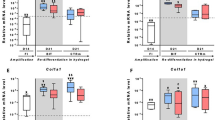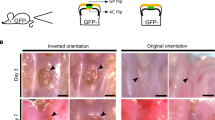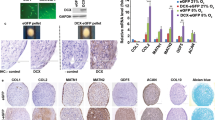Abstract
Traumatic articular cartilage lesions have a limited capacity to heal. We tested the hypothesis that overexpression of a human insulin-like growth factor I (IGF-I) cDNA by transplanted articular chondrocytes enhances the repair of full-thickness (osteochondral) cartilage defects in vivo. Lapine articular chondrocytes were transfected with expression plasmid vectors containing the cDNA for the Escherichia coli lacZ gene or the human IGF-I gene and were encapsulated in alginate. The expression patterns of the transgenes in these implants were monitored in vitro for 36 days. Transfected allogeneic chondrocytes in alginate were transplanted into osteochondral defects in the trochlear groove of rabbits. At three and 14 weeks, the quality of articular cartilage repair was evaluated qualitatively and quantitatively. In vitro, IGF-I secretion by implants constructed from IGF-I-transfected chondrocytes and alginate was 123.2±22.3 ng/107 cells/24 h at day 4 post transfection and remained elevated at day 36, the longest time point evaluated. In vivo, transplantation of IGF-I implants improved articular cartilage repair and accelerated the formation of the subchondral bone at both time points compared to lacZ implants. The data indicate that allogeneic chondrocytes, transfected by a nonviral method and cultured in alginate, are able to secrete biologically relevant amounts of IGF-I over a prolonged period of time in vitro. The data further demonstrate that implantation of these composites into deep articular cartilage defects is sufficient to augment cartilage defect repair in vivo. These results suggest that therapeutic growth factor gene delivery using encapsulated and transplanted genetically modified chondrocytes may be applicable to sites of focal articular cartilage damage.
This is a preview of subscription content, access via your institution
Access options
Subscribe to this journal
Receive 12 print issues and online access
$259.00 per year
only $21.58 per issue
Buy this article
- Purchase on Springer Link
- Instant access to full article PDF
Prices may be subject to local taxes which are calculated during checkout



Similar content being viewed by others
References
Buckwalter JA, Mankin HJ . Articular cartilage repair and transplantation. Arthritis Rheum 1998; 41: 1331–1342.
Hunziker EB, Rosenberg LC . Repair of partial-thickness defects in articular cartilage: cell recruitment from the synovial membrane. J Bone Joint Surg Am 1996; 78: 721–733.
Nixon AJ, Fortier LA, Williams J, Mohammed H . Enhanced repair of extensive articular defects by insulin-like growth factor-I-laden fibrin composites. J Orthop Res 1999; 17: 475–487.
Sellers RS et al. Repair of articular cartilage defects one year after treatment with recombinant human bone morphogenetic protein-2 (rhBMP-2). J Bone Joint Surg Am 2000; 82: 151–160.
Sellers RS, Peluso D, Morris EA . The effect of recombinant human bone morphogenetic protein-2 (rhBMP-2) on the healing of full-thickness defects of articular cartilage. J Bone Joint Surg Am 1997; 79: 1452–1463.
Fortier LA, Mohammed HO, Lust G, Nixon AJ . Insulin-like growth factor-I enhances cell-based repair of articular cartilage. J Bone Joint Surg Br 2002; 84: 276–288.
Trippel SB, Van Wyk JJ, Foster MB, Svoboda ME . Characterization of a specific somatomedin-c receptor on isolated bovine growth plate chondrocytes. Endocrinology 1983; 112: 2128–2136.
Trippel SB . Growth factor actions on articular cartilage. J Rheumatol Suppl 1995; 43: 129–132.
Trippel SB et al. Effect of somatomedin-C/insulin-like growth factor I and growth hormone on cultured growth plate and articular chondrocytes. Pediatr Res 1989; 25: 76–82.
Rogachefsky RA, Dean DD, Howell DS, Altman RD . Treatment of canine osteoarthritis with insulin-like growth factor-1 (IGF-1) and sodium pentosan polysulfate. Osteoarthr Cartilage 1993; 1: 105–114.
Madry H, Zurakowski D, Trippel SB . Overexpression of human insulin-like growth factor-I promotes new tissue formation in an ex vivo model of articular chondrocyte transplantation. Gene Ther 2001; 8: 1443–1449.
Madry H et al. Gene transfer of a human insulin-like growth factor I cDNA enhances tissue engineering of cartilage. Hum Gene Ther 2002; 13: 1621–1630.
Madry H et al. Sustained transgene expression in cartilage defects in vivo after transplantation of articular chondrocytes modified by lipid-mediated gene transfer in a gel suspension delivery system. J Gene Med 2003; 5: 502–509.
Gelse K et al. Articular cartilage repair by gene therapy using growth factor-producing mesenchymal cells. Arthritis Rheum 2003; 48: 430–441.
Gelse K et al. Fibroblast-mediated delivery of growth factor complementary DNA into mouse joints induces chondrogenesis but avoids the disadvantages of direct viral gene transfer. Arthritis Rheum 2001; 44: 1943–1953.
Bonaventure J et al. Reexpression of cartilage-specific genes by dedifferentiated human articular chondrocytes cultured in alginate beads. Exp Cell Res 1994; 212: 97–104.
Lemare F et al. Dedifferentiated chondrocytes cultured in alginate beads: restoration of the differentiated phenotype and of the metabolic responses to interleukin-1beta. J Cell Physiol 1998; 176: 303–313.
von der Mark K, Gauss V, von der Mark H, Mueller P . Relationship between cell shape and type of collagen synthesis as chondrocytes lose their cartilage phenotype in culture. Nature 1977; 267: 531–532.
Benya PD, Padilla SR, Nimni ME . Independent regulation of collagen types by chondrocytes during the loss of differentiated function in culture. Cell 1978; 15: 1313–1321.
You JO et al. Preparation of regular sized Ca-alginate microspheres using membrane emulsification method. J Microencapsul 2001; 18: 521–532.
Zimmermann U et al. Hydrogel-based non-autologous cell and tissue therapy. Biotechniques 2000; 29: 564–572.
Diduch DR, Jordan LC, Mierisch CM, Balian G . Marrow stromal cells embedded in alginate for repair of osteochondral defects. Arthroscopy 2000; 16: 571–577.
Mierisch CM et al. Chondrocyte transplantation into articular cartilage defects with use of calcium alginate: the fate of the cells. J Bone Joint Surg Am 2003; 85-A: 1757–1767.
Mierisch CM et al. Transforming growth factor-beta in calcium alginate beads for the treatment of articular cartilage defects in the rabbit. Arthroscopy 2002; 18: 892–900.
Rokstad AM et al. Transplantation of alginate microcapsules with proliferating cells in mice: capsular overgrowth and survival of encapsulated cells of mice and human origin. Ann NY Acad Sci 2001; 944: 216–225.
Dinser R et al. Comparison of long-term transgene expression after non-viral and adenoviral gene transfer into primary articular chondrocytes. Histochem Cell Biol 2001; 116: 69–77.
Soon-Shiong P et al. Insulin independence in a type 1 diabetic patient after encapsulated islet transplantation. Lancet 1994; 343: 950–951.
Loeser RF, Shanker G . Autocrine stimulation by insulin-like growth factor 1 and insulin-like growth factor 2 mediates chondrocyte survival in vitro. Arthritis Rheum 2000; 43: 1552–1559.
Grande DA et al. The repair of experimentally produced defects in rabbit artiular cartilage by autologous chondrocyte transplantation. J Orthop Res 1989; 7: 208–218.
Bentley G, Greer III RB . Homotransplantation of isolated epiphyseal and articular cartilage chondrocytes into joint surfaces of rabbits. Nature 1971; 230: 385–388.
Furukawa T, Eyre DR, Koide S, Glimcher MJ . Biochemical studies on repair cartilage resurfacing experimental defects in the rabbit knee. J Bone Joint Surg Am 1980; 62: 79–89.
Shapiro F, Koide S, Glimcher MJ . Cell origin and differentiation in the repair of full-thickness defects of articular cartilage. J Bone Joint Surg Am 1993; 75: 532–553.
Hunziker EB . Biologic repair of articular cartilage. Defect models in experimental animals and matrix requirements. Clin Orthop 1999; 367S: S135–S146.
Bae WC, Rivard KL, Law AW, Sah RL . Indentation testing is sensitive to cartilage laceration and repair. Transactions 48th Ann Mtg Orthop Res Soc 2002; 27: 399.
Madry H, Trippel SB . Efficient lipid-mediated gene transfer to articular chondrocytes. Gene Ther 2000; 7: 286–291.
Acknowledgements
We thank J Becker, E Gluding and T Thurn for expert technical assistance and B Vollmar for valuable discussions. This study is supported by the Deutsche Forschungsgemeinschaft (DFG MA 2363/1-1, H.M.), the AO ASIF Foundation and NIH Grants AR 31068 and AR 45749 (SBT).
Author information
Authors and Affiliations
Additional information
Part of this work was presented at the 49th Annual Meeting of the Orthopaedic Research Society, February 2–5, 2003, New Orleans, Louisiana, USA
Rights and permissions
About this article
Cite this article
Madry, H., Kaul, G., Cucchiarini, M. et al. Enhanced repair of articular cartilage defects in vivo by transplanted chondrocytes overexpressing insulin-like growth factor I (IGF-I). Gene Ther 12, 1171–1179 (2005). https://doi.org/10.1038/sj.gt.3302515
Received:
Accepted:
Published:
Issue Date:
DOI: https://doi.org/10.1038/sj.gt.3302515
Keywords
This article is cited by
-
Hyaluronic acid-binding insulin-like growth factor-1: Creation of a gene encoding a bifunctional fusion protein
Molecular Biology Reports (2020)
-
Current Applications of Growth Factors for Knee Cartilage Repair and Osteoarthritis Treatment
Current Reviews in Musculoskeletal Medicine (2020)
-
Where is human-based cellular pharmaceutical R&D taking us in cartilage regeneration?
3 Biotech (2020)
-
Biomaterial-guided delivery of gene vectors for targeted articular cartilage repair
Nature Reviews Rheumatology (2019)
-
Determination of effective rAAV-mediated gene transfer conditions to support chondrogenic differentiation processes in human primary bone marrow aspirates
Gene Therapy (2015)



